Analyzing Intel Core M Performance: How 5Y10 can beat 5Y71 & the OEMs' Dilemma
by Brett Howse & Ian Cutress on April 8, 2015 8:00 AM ESTCinebench R15 Single-Threaded Results
Cinebench will run the CPU up to 100% load for the duration of the test. As this is the single-threaded run, only one core will be active, which should in theory provide more headroom for that one core than when all cores (physical and virtual) are loaded. There is no burst workload here at all, and sustained single-threaded performance is the key for this test.
The Core i5 does exactly what would be expected for this benchmark. With just a single core loaded, the cooling system has no issues keeping the CPU from throttling. It maintains an extremely consistent CPU frequency during the run. This cannot be said of the two Core M-5Y71 devices though. The Dell Venue 11 Pro starts off with quite a high frequency, but as the temperature increases, the CPU drops in frequency to keep below the threshold of 90°C set on the SoC. At any opportunity, it increases its CPU frequency to try to increase performance, but generally that does not last for very long, and it ends up falling back down. The Yoga 3 Pro on the other hand, has a much lower allowed SoC temperature, with Lenovo locking in on 65°C as their maximum target temperature. This keeps the frequency down.
The ASUS Zenbook has an entirely flat CPU line though. The excellent heat dissipation of the chassis allows it to run for the duration of the benchmark with no throttling at all. It has to be noted though that the maximum CPU frequency is a quite a bit lower than the 5Y71 devices, topping out at 2.0 GHz versus 2.9 GHz for 5Y71. It would be very interesting to see how the UX305 would do with the faster CPU inside, and if it would run into throttling issues as well.

Looking at the average CPU frequency over the run shows that the i5 clearly has the most headroom, which is not surprising. Averages are only part of the story though, with both of the 5Y71 devices being able to jump past the 5Y10's frequency several times during the test.
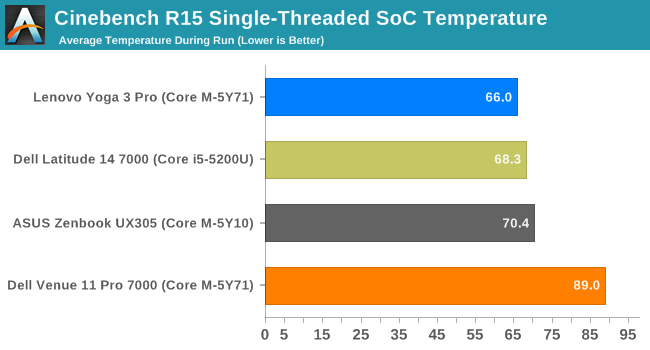
Looking at temperatures, it's interesting to note that the Dell Venue 11 Pro has the top-tier Core M-5Y71, but it puts that processor in what is the smallest chassis and with a plastic exterior. Consequently it quickly loads up to its maximum temperature and stays there for the duration. The rest of the devices stay much cooler with just a single core loaded.
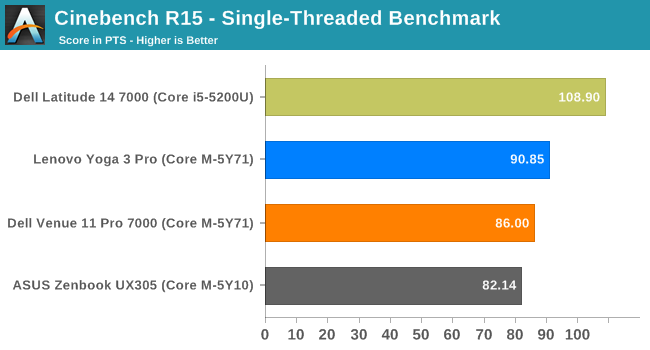
Here we have the actual benchmark results. On single-threaded workloads, the 5Y71 can and does outperform 5Y10. Despite the average CPU frequencies being lower on both 5Y71 devices, they had enough headroom when necessary to jump past the very consistent 5Y10. None of them can match the Core i5 in this test. It is actually very interesting that the highest scoring Core M in this test has the lowest average CPU frequency.


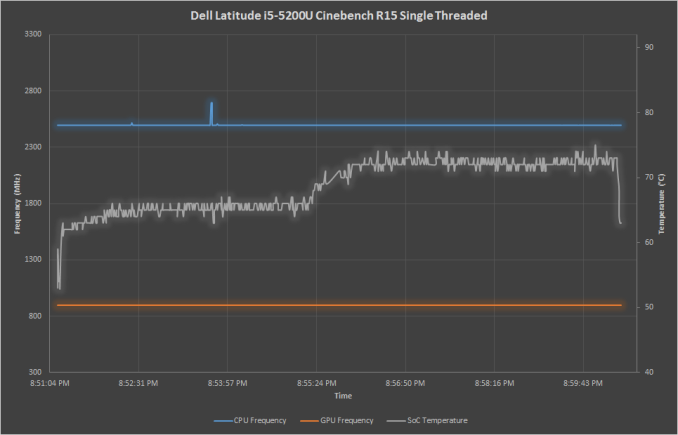
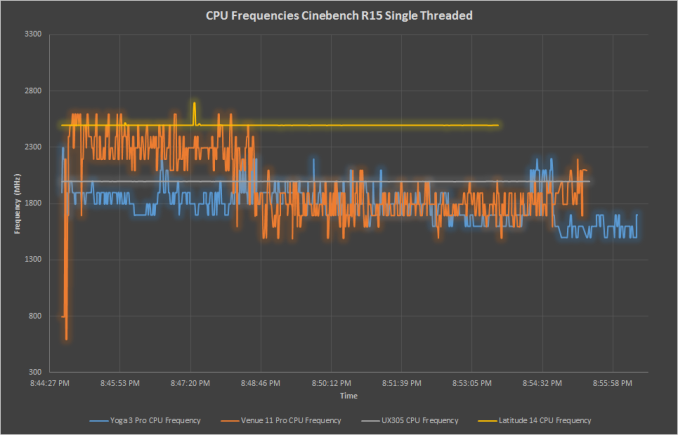
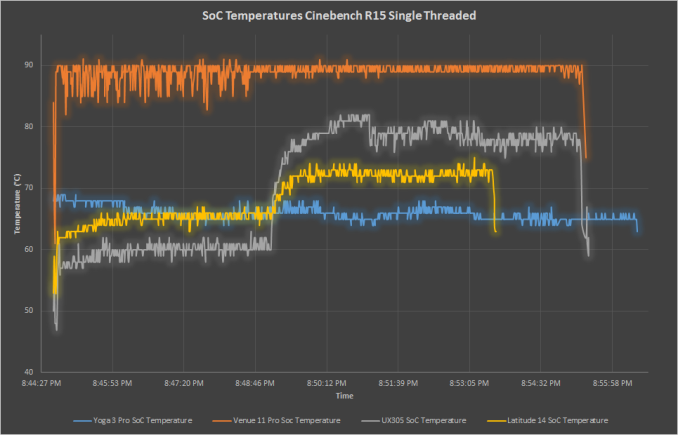








110 Comments
View All Comments
OneCosmic833 - Friday, April 10, 2015 - link
I don't really understand, why don't the manufacturers put a little bigger heatsink with a FAN of bigger diameter into these portable devices, is it such a problem??? Production costs reduction or bad engineering? I think it would be also possible to keep the same weight if they cut some bulk mass from somewhere else of the device. Simply this throttling is not acceptable for me and an i7 should not have lower performance than i5 in sustained load...This is very very sad for us consumers, like how the manufacturers skimp us ! ! !metayoshi - Friday, April 10, 2015 - link
Great article!I'm very interested in this, though, after reading the whole article: I noticed the Asus laptop with the metal chassis was the one with the 5Y10, and the two devices that are usable as a tablet/is a tablet are the two devices with the 5Y71. However, I know that the Venue 11 Pro comes with a 5Y10 for its base configuration, so it would be interesting to see how that 5Y10 version compares vs the 5Y71 version, knowing it is thermally handicapped compared to the Lenovo, with its fan, and the Asus, which is a laptop with a metal chassis.
I was originally eyeing the Venue 11 Pro, but I jumped on the preorders of the less powerful but still capable Surface 3 with the new Atom SoC. I'm really intrigued by Core M, but all these stories of throttling and whatnot are keeping me away for now.
serendip - Friday, April 10, 2015 - link
Intel has a decent mobile chip with Atom. Core M, not so much. I would rather have a slower Atom chip that costs a lot less and can turbo for long periods than a Core M with much higher performance that isn't accessible to the user thanks to constant throttling. Maybe there should be a caveat on Core M devices like "2.4 GHz processor (for 10 seconds only), base 1 GHz". That way consumers know what they're really in for.ahfei - Tuesday, April 14, 2015 - link
Is 2.6GHz the maximum turbo speed for M-5Y71 for 2 cores, judging from the graph? Cannot find that info anywhere and some even stated the maximum 2.9GHz is for both cores!Brett Howse - Sunday, April 19, 2015 - link
I have never seen them go over 2.6 GHz for both cores. 2.9 GHz seems to be just for a single core.boe_d - Saturday, April 18, 2015 - link
I like the Sony Vaio Z approach - balls the walls hardware, fast processing power, fast storage, fast video and LIGHT. Still lighter than most laptops 5 years later and faster than many of them too! Battery power wasn't great but it had an easy to replace battery.RanBuch - Saturday, July 18, 2015 - link
I own a Lenovo yoga 3 pro. Can I configure the SoC temperature from 65°C to a higher value? I use the device as a "desktop" more often then a tablet and would love to get more juice from my machine even at the expense of the device "overheating" a little bit.HP - Wednesday, August 5, 2015 - link
These processors are perfectly decent. But at the same time, really novel due to the fact that no active cooling is required to run them. This in my view is a positive progression in CPUs together with the SoC philosophy. To have everything integrated into a smaller space. Many users might complain about performance but I bet they don't use their i5 or i7 machines to the fullest potential either. Core-M performance is perfectly decent. Granted, the only slow downs I have experienced is when compiling a Linux kernel say or running multiple FHD videos. But such tasks are run on a less than regular basis so a slight slow down in speed during these exercises is acceptable. The rest of the tasks get carried out very well in a thin, light and quiet design.Atreyiu - Tuesday, February 2, 2016 - link
I know many will disagree with me, but I am a regular user and I hate when my Venue 11 Pro 7140 (5Y10, 64 Gb, 04 Gb RAM) is heated so much that I can not put my right hand in it, that temperature is unbearable from 55 ° C upwards. Should not rise beyond what your skin can handle. This happens pretty and very quickly, then to lower spend enough time. I'm thinking let go of it and look for an alternative. I wanted a balanced team between productivity and way of life, but these temperature rises disenchanted me and the only thing that bothers me because it is fast and has no crashes or anything like that.SandraGok - Tuesday, June 9, 2020 - link
I'm not just inviting you! But it will be interesting for sure loveawake.ru